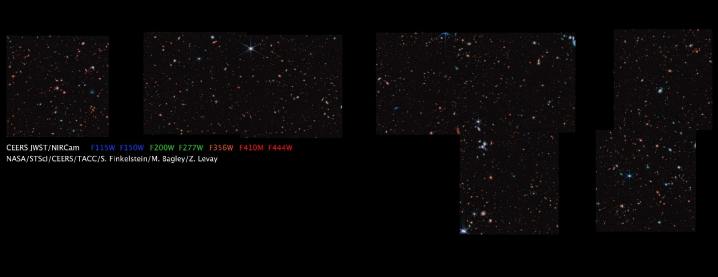The wonders of the universe are on full display once again thanks to the James Webb Space Telescope. A team from a Webb survey program has released the largest Webb image yet, showing a dazzling array of galaxies spread across the background of space.
The image is from the CEERS or Cosmic Evolution Early Release Science program, which surveys a patch of the sky near the handle of the Big Dipper constellation. The aim of the survey is to search for extremely distant galaxies by looking at a generally dim area of the sky that is far away from bright light sources, such as the plane of the solar system and the center of the Milky Way. By looking at this dim area, Webb can see very faint distant galaxies as they aren’t blotted out by nearer bright light sources.

“I have been waiting so long to share this, and it is finally time!” researcher Rebecca Larson cheerfully announced on Twitter. “Do you want to see THE BIGGEST IMAGE #JWST has taken of galaxies so far?! Our color mosaic image from @ceers_jwst is ready, and there are SO MANY GALAXIES in it!”
“Check out our amazing color image,” lead researcher Steve Finkelstein chimed in as well. “Download the high-res version and lose yourself in all the galaxies!”
As the researchers suggest, you should go to the CEERS website to see the high-resolution image in all its incredible detail. This is Webb’s largest survey area yet and consists of four images of the 10 total planned for the survey, taken using Webb’s NIRCam instrument in June 2022. More observations are scheduled for later this year.

As well as bringing us stunning images to look at, such surveys play an important role in identifying interesting targets for follow-up study. Included in this mosaic are objects like a set of interacting galaxies dubbed the “Space Kraken,” a supernova spotted in a pair of interacting galaxies, and an extremely distant galaxy named after Finkelstein’s daughter Maisie.
Further surveys are to come with Webb once CEERS wraps up, including the Next Generation Deep Extragalactic Exploratory Survey, or NGDEEP, and the James Webb Space Telescope Advanced Deep Extragalactic Survey, or JADES.
Editors' Recommendations
- James Webb observes extremely hot exoplanet with 5,000 mph winds
- Biggest stellar black hole to date discovered in our galaxy
- Stunning image shows the magnetic fields of our galaxy’s supermassive black hole
- See the stunning Vela supernova remnant in exquisite detail in expansive image
- The expansion rate of the universe still has scientists baffled



